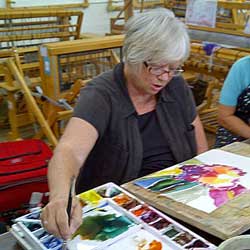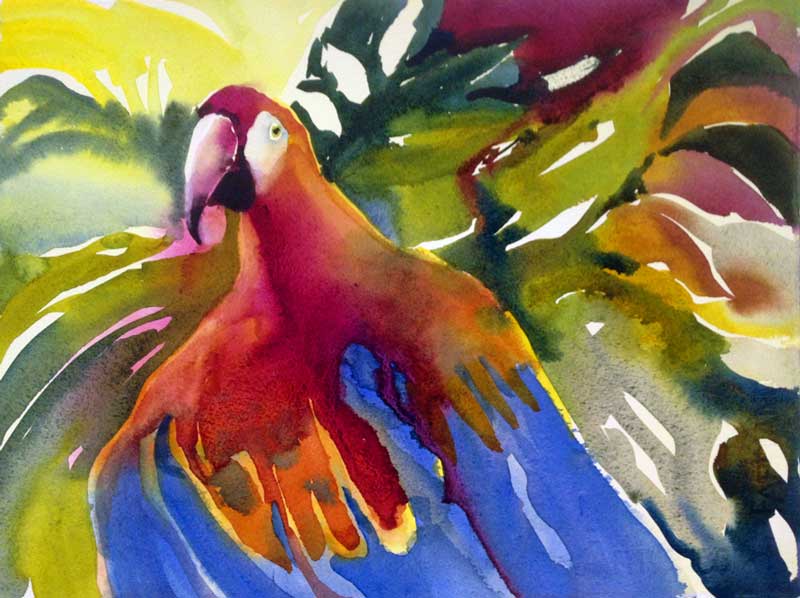 I was still debating in my mind about what to paint for the first Cloudcroft workshop demo. In a few minutes my 15 students would gather in front of the mirror to watch – and I quickly settled on the colorful scarlet macaw. Rather than paint the more limited colors of ubiquitous evergreens in the New Mexico high mountain elevation, I decided that the vivid scarlets, yellows and blue parrot feathers would provide plenty of creative opportunities to explore and show different watercolor pigments. After a cursory sketch on the paper, I grabbed my largest wash brush and applied my accustomed yellow under wash (a wet wash over the entire paper). Now with the paper all wet, I would have to wait to apply more waterecolor so it wouldn’t run all over. I figured it would dry fast in New Mexico. Not fast enough. As I touched my magenta drenched brush to the paper, I gulped as the vivid color exploded away from the parrot’s neck and into what was to be the non-magenta background. The quiet of my students assured me that they were similarly alarmed. Now what? I could start again. No. Better to allow the ‘mistake’ to chart a new course, a new path. Suddenly I found myself in the transitory territory of my creative self – and I continued, balancing and playing with the varied paints and pigments as I went.
I was still debating in my mind about what to paint for the first Cloudcroft workshop demo. In a few minutes my 15 students would gather in front of the mirror to watch – and I quickly settled on the colorful scarlet macaw. Rather than paint the more limited colors of ubiquitous evergreens in the New Mexico high mountain elevation, I decided that the vivid scarlets, yellows and blue parrot feathers would provide plenty of creative opportunities to explore and show different watercolor pigments. After a cursory sketch on the paper, I grabbed my largest wash brush and applied my accustomed yellow under wash (a wet wash over the entire paper). Now with the paper all wet, I would have to wait to apply more waterecolor so it wouldn’t run all over. I figured it would dry fast in New Mexico. Not fast enough. As I touched my magenta drenched brush to the paper, I gulped as the vivid color exploded away from the parrot’s neck and into what was to be the non-magenta background. The quiet of my students assured me that they were similarly alarmed. Now what? I could start again. No. Better to allow the ‘mistake’ to chart a new course, a new path. Suddenly I found myself in the transitory territory of my creative self – and I continued, balancing and playing with the varied paints and pigments as I went.
 In painting, pigments are bound together in some kind of liquid – wax (encaustic), egg yolk (tempera), linseed oil (oil paint) or water (watercolor, acrylic, gouache). Watercolor’s watery base enables incredible opportunities for pigments to flow, mingle and mix according to their chemical make-up. Water also enables transparency. It certainly isn’t for everyone and more than a few have given up their watercolors for oils in frustration over how to control the water based media. Through the years I’ve come to appreciate what painting with this unique medium of watercolor has taught me. And my learning has extended well beyond the paper and into living my life.
In painting, pigments are bound together in some kind of liquid – wax (encaustic), egg yolk (tempera), linseed oil (oil paint) or water (watercolor, acrylic, gouache). Watercolor’s watery base enables incredible opportunities for pigments to flow, mingle and mix according to their chemical make-up. Water also enables transparency. It certainly isn’t for everyone and more than a few have given up their watercolors for oils in frustration over how to control the water based media. Through the years I’ve come to appreciate what painting with this unique medium of watercolor has taught me. And my learning has extended well beyond the paper and into living my life.
Some insights
- There are no mistakes – just new opportunities. The vivid magenta shooting away from the parrot neck was surely a “mistake” – but instead of trying to stop it I chose to see how far it would go – knowing that at least in watercolor, I could always paint something really dark over it later. How many times in life we find a ‘mistake’ or wrong turn eventually leads to a new possibility, a new direction?
- Jump in. It is always scary to take a creative leap. Often the next path or direction only shows up after that first step off the cliff. We are all creative once we get through the perceived barrier of fear. I remember the book I bought and put in my bookshelf but never read. Feel the Fear and Do It Anyway. The title said it all.
- Start with a big brush. I’ve learned to use a 1 ½” flat brush in painting and have taught myself how to use its edges and corners for most later details. A big brush makes a decisive stroke and is a great way to begin. Too much messing around with details at the beginning just prolongs the process. Besides, a decisive stroke at the beginning looks confident – and maybe I’ll actually feel it once I do it.
- Go with the attitude of “I can fix anything”. I don’t think I could do a demo if I didn’t believe I could ‘fix’ anything. Thanks to my first teacher, Deanne, whose reply decades ago to my frustration in class I’ll never forget. I’d spent weeks on a large painting until I had really overworked the poor thing and I exclaimed, “Deanne, I have ruined this.” She replied without looking up, “Is it all black?” There is always something that can be done to improve a painting. Believing you can fix something if you have to often propels one through the ‘deer in the headlights’ immobility.
- All paintings go through an “adolescence” period where they are awkward, unappealing and disappointing. Mostly they are just not finished. 80% of paintings on their way to completion get thrown out at this time. Don’t.
- There is ALWAYS something beautiful in any painting. In my workshops we have our first critiques at a painting’s adolescent stage and I ask my students “What is working well in this painting?” Some students will insist on answering that “Nothing is working!” Often the negative declaration about their painting is really more about themselves. When prompted they actually can find something they like – and that’s exactly where their energy needs to be re-focused. There is something beautiful or valuable in every experience.
- Contrasts matter. Contrasts in values (darks and lights), colors, and sizes of shapes are what make paintings appeal to our eyes. Darks are needed in order to allow the lights to glow, colors are enhanced by others nearby and large shapes allow smaller ones to dance. Maybe it is the same in life – that our dark times make the light times dazzle and too much of anything diminishes its power.
- Shut out the negative voice in your head. While, painting try to disregard the voice from your past that still whispers “you don’t know what you are doing” or “this is awful”. If you heed this voice, you’ll likely stop. We all have these voices and they pop up often when we’re on the verge of something exciting. When I’m doing a demo I can count on one or two dire utterings from my past and all I can do is refuse to listen. Over and over. I have found it useful to treat my ‘negative voice’ as a belligerent and willful bully, not needed or helpful in a creative situation. It appears to me that the bully in my head is intimidated by my creativity. If I just keep going it eventually stops whispering.
The demo went just fine and though it was not quite finished, I was satisfied with the result. A few days later one of my students asked to buy it. I don’t know if she wanted the reminder about the ‘magenta mistake’ or if she really loved the painting.
I decided it didn’t matter.



